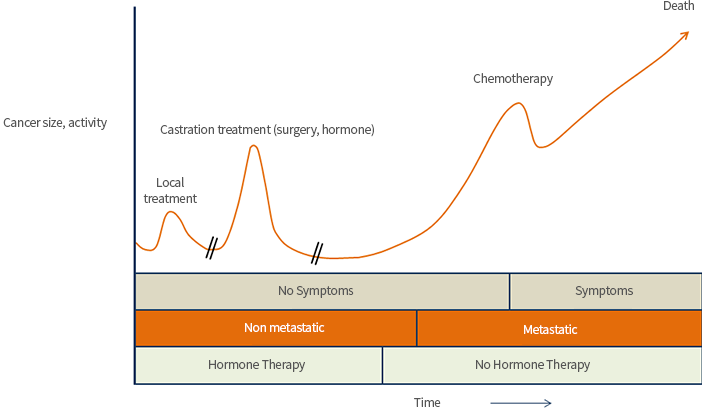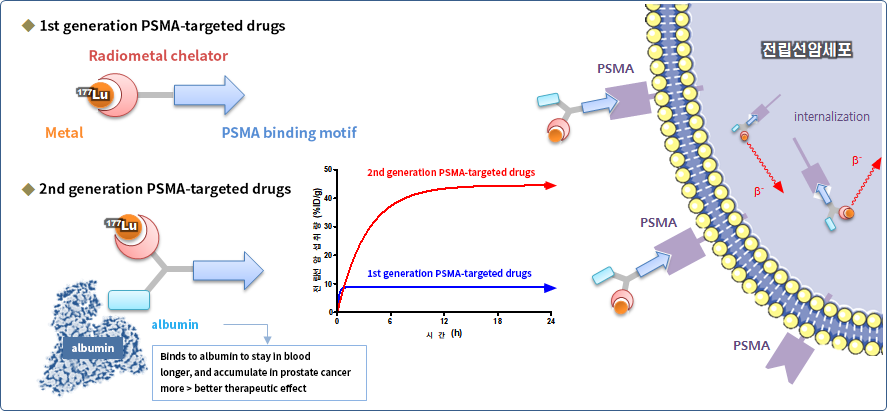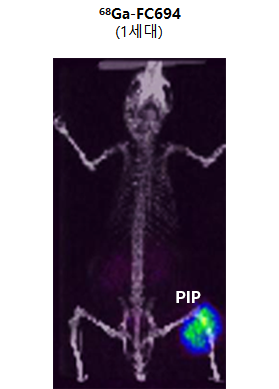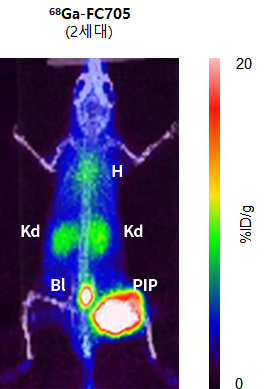177Lu-FC705
Recurrence and Metastasis of Prostate Cancer
Biochemical recurrence (BCR) is defined as elevated PSA level after local treatment such as prostatectomy, and it occurs at about 35% (27~53%) rate. This implies that patients who have undergone prostatectomy still have possibility for BCR. But elevated PSA level does not always lead to recurrence or metastatic symptoms of prostate cancer. Therefore, more sensitive and powerful diagnostic method is needed.
Castration-Resistant Prostate Cancer (CRPC)
Patients with confirmed recurrence or metastasis generally undergo hormone therapy in which male hormone inhibitors are injected to prevent further progression of prostate cancer. In 1-2 years after treatment with hormone therapy, the cancer develops into CRPC that hormone therapy does not have any effect on. Thereafter, the symptoms develop rapidly and cancer metastasizes to all over the body. At this point, the patient is treated with chemotherapy; however, eventually die within few months.
PSMA- PSMA-targeted Radiopharmaceutical for Therapy
We are currently developing 18F-FC303 as a diagnostic PET radiopharmaceutical for prostate cancer. In addition, PSMA-targeted therapeutic radiopharmaceutical conjugated with Lu-177 is also being investigated. Lu-177 is a beta particle-emitting radioisotope that has been proven to have excellent therapeutic effect in CRPC patients when combined with PSMA-targeted compound. For example, 177Lu-PSMA-617, developed by German researchers, has eliminated majority of prostate cancer in clinical trials involving CRPC patients. But 177Lu-PSMA-617 causes severe adverse effects due to it’s high non-specific uptake in normal organs such as salivary gland, kidneys, liver, pancreas, and intestines. Therefore 177Lu-PSMA-617 may treat prostate cancer but decline the quality of life of patients due to side effects at the same time.

2nd Generation PSMA-targeted Therapeutic Radiopharmaceuticals
Since 177Lu-PSMA-617 injection dose is high, the radiation exposure to normal organs such as salivary glands and kidneys is inevitable. Many patients who have participated in clinical trials actually complained of various side effects from salivary gland radiation exposure. Recently, studies on PSMA-targeted compounds with albumin-binding functional group have been reported. Albumin is the most abundant protein in the blood (40 mg/mL) and the introduction of albumin conjugates into the drug increases the drug's retention time in the blood, resulting in more accumulation of the drug in the target area. This suggests that lower dose than 177Lu-PSMA-617 can significantly reduce damage to normal tissues have while producing the same therapeutic effect. . These 2nd generation PSMA-targeted radiopharmaceuticals are still in basic research stage throughout the world.

FC705
FC705 belongs to the 2nd generation of albumin binders introduced drugs. Its hydrophilicity is higher than that of other compounds, and has low nonspecific binding. MicroPET/CT images were acquired by injecting 68Ga-FC705, instead of 177Lu-FC705, into tumor xenograft model of mice (Figure 3). The results showed much higher prostate cancer uptake (%ID/g) in 68Ga-FC705 compared to 68Ga-FC694, the 1st generation compound without albumin binder. 68Ga-FC694 has a relatively low uptake in prostate cancer cells, but it is quickly removed from the body by urine and shows extremely low uptake in normal organs (Figure 3, left). This suggests that FC705 will have constantly increasing uptake in prostate cancer due to the introduction of albumin binder while it will be rapidly excreted from normal organs. In this regard, 177Lu labeled 177Lu-FC705 can be expected to have high therapeutic effect and very low damage to normal organs. Currently, efficacy of 177Lu-FC705 is being tested using prostate cancer mouse model.


